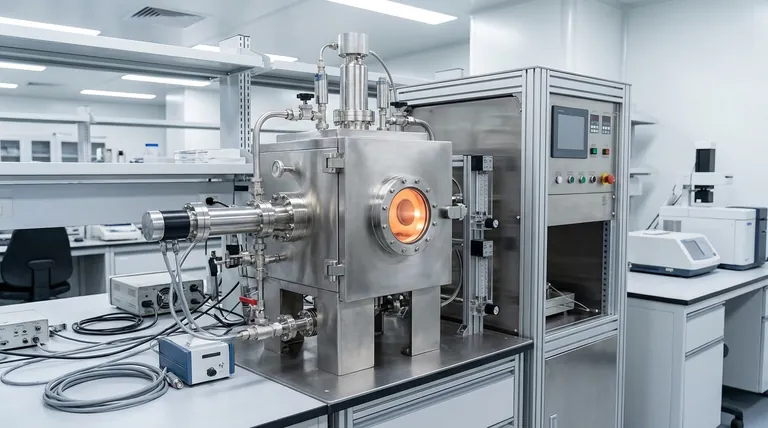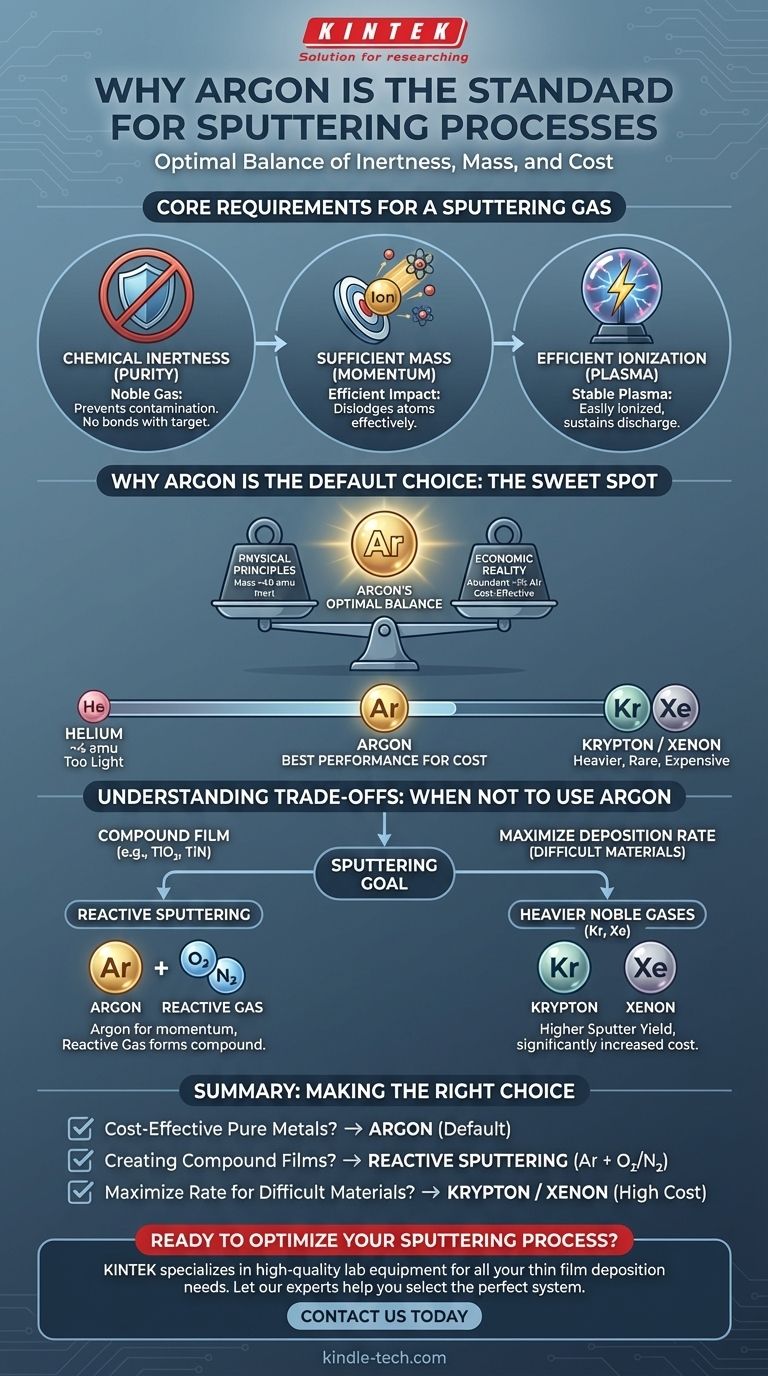In sputter deposition, the choice of gas is fundamental to the entire process. Argon is the standard gas used for sputtering because it is a noble gas, meaning it is chemically inert and will not react with the target material. This inertness, combined with a relatively high atomic mass, allows argon ions to effectively bombard and dislodge atoms from the target without contaminating the resulting thin film.
The selection of a sputtering gas is a trade-off between chemical inertness and physical momentum. Argon provides an optimal balance: it is heavy enough to efficiently eject target atoms while being chemically inert, preventing it from contaminating the target or the final deposited film.

The Core Requirements for a Sputtering Gas
To understand why argon is the default, we must first define what makes a gas effective for this physical process. The ideal gas must satisfy three primary criteria.
Chemical Inertness for Purity
Sputtering is a physical vapor deposition (PVD) process, not a chemical one. The goal is to physically knock atoms loose from a source (the "target") and have them deposit as a pure film on a substrate.
Using an inert gas is critical because it will not form chemical bonds with the target material or the atoms traveling through the vacuum chamber. This ensures the material that arrives at the substrate is as pure as the source it came from.
Sufficient Mass for Momentum Transfer
The sputtering process is a momentum transfer event. An ion from the gas plasma is accelerated by an electric field and collides with the target.
Think of it like a game of billiards. A heavier ion, like argon, acts like a bowling ball hitting pins—it has enough mass and momentum to effectively dislodge atoms from the target. A much lighter ion, like helium, would be like a ping-pong ball; it would bounce off without dislodging much material.
Efficient Ionization in Plasma
The sputtering gas must first be turned into a plasma (a quasi-neutral gas of ions and electrons) by a strong electric field. The gas must be able to ionize efficiently and sustain this plasma state stably under vacuum conditions. Noble gases like argon perform this role exceptionally well and do not decompose in the glow discharge.
Why Argon is the Default Choice
Argon hits the sweet spot between physical principles and economic reality, making it the workhorse of the sputtering industry.
Argon's Optimal Balance
As a noble gas, argon is completely inert. With an atomic mass of approximately 40 amu, it is significantly heavier than other common gases like nitrogen (~28 amu) and much heavier than helium (~4 amu), making it very effective at sputtering.
The Factor of Abundance and Cost
Argon makes up nearly 1% of Earth's atmosphere, making it abundant and relatively inexpensive to purify. While heavier noble gases like Krypton (Kr) and Xenon (Xe) are even better at sputtering due to their higher mass, they are also far rarer and exponentially more expensive.
For the vast majority of applications, argon provides the best performance for the cost.
Understanding the Trade-offs: When Not to Use Argon
While argon is the standard, it is not the only choice. The exceptions prove the rule and highlight the underlying principles of the process.
The Role of Reactive Sputtering
Sometimes, the goal is not to deposit a pure material but a compound. In reactive sputtering, a reactive gas like oxygen or nitrogen is intentionally introduced into the chamber along with argon.
The argon ions still do the primary work of sputtering the metallic target (e.g., titanium). However, the reactive gas combines with the sputtered titanium atoms in transit or on the substrate surface to form a new compound, such as titanium dioxide (TiO₂) or titanium nitride (TiN).
The Case for Heavier Gases
For very dense materials that are difficult to sputter, or in high-end applications where maximizing the deposition rate is the top priority, a heavier noble gas may be used.
Krypton or Xenon provide a higher sputter yield (more sputtered atoms per incident ion) than argon. This performance gain comes at a significant cost increase, limiting their use to specialized research or demanding industrial processes.
Making the Right Choice for Your Process
Your choice of gas should be directly informed by the goal of your deposition.
- If your primary focus is cost-effective deposition of pure metals or materials: Argon is your default choice, offering the best balance of performance, purity, and cost.
- If your primary focus is creating a compound film (e.g., an oxide, nitride, or carbide): You will use a reactive sputtering process, blending argon with a specific reactive gas like O₂ or N₂.
- If your primary focus is maximizing the deposition rate of a difficult-to-sputter material: Consider a heavier, more expensive noble gas like krypton or xenon if the increased throughput justifies the cost.
Understanding these core principles allows you to select not just the standard gas, but the correct gas for your specific technical objective.
Summary Table:
| Gas Property | Why It Matters for Sputtering | Argon's Advantage |
|---|---|---|
| Chemical Inertness | Prevents contamination of the target and deposited film. | Noble gas; does not react with target material. |
| Atomic Mass (~40 amu) | Determines efficiency of momentum transfer to dislodge atoms. | Optimal mass for effective sputtering yield. |
| Ionization Efficiency | Essential for creating and sustaining the plasma. | Ionizes efficiently and stably in a glow discharge. |
| Cost & Abundance | Impacts the overall cost of the deposition process. | Makes up ~1% of atmosphere; highly cost-effective. |
Ready to optimize your sputtering process? The right equipment is just as critical as the right gas. KINTEK specializes in high-quality lab equipment and consumables for all your laboratory needs. Our experts can help you select the perfect sputtering system for your specific application, whether you're depositing pure metals or complex compounds. Contact us today to discuss how we can enhance your thin film deposition and achieve your technical objectives!
Visual Guide

Related Products
- Inclined Rotary Plasma Enhanced Chemical Vapor Deposition PECVD Equipment Tube Furnace Machine
- HFCVD Machine System Equipment for Drawing Die Nano-Diamond Coating
- 915MHz MPCVD Diamond Machine Microwave Plasma Chemical Vapor Deposition System Reactor
- Laboratory Sterilizer Lab Autoclave Pulse Vacuum Lifting Sterilizer
- Vacuum Hot Press Furnace Machine for Lamination and Heating
People Also Ask
- What is the difference between CVD and PECVD? Choose the Right Thin-Film Deposition Method
- What is meant by vapor deposition? A Guide to Atomic-Level Coating Technology
- What is the difference between PECVD and CVD? Unlock the Right Thin-Film Deposition Method
- How does plasma enhanced CVD work? Achieve Low-Temperature, High-Quality Thin Film Deposition
- What materials are deposited in PECVD? Discover the Versatile Thin-Film Materials for Your Application



















